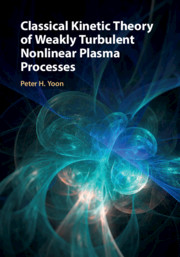3653 results in ebooks in fluid mechanics

Classical Kinetic Theory of Weakly Turbulent Nonlinear Plasma Processes
-
- Published online:
- 26 August 2019
- Print publication:
- 12 September 2019
Contents
-
- Book:
- Chemical Kinetics in Combustion and Reactive Flows
- Published online:
- 16 August 2019
- Print publication:
- 22 August 2019, pp ix-xii
-
- Chapter
- Export citation
3 - Software Tools for the Support of Calculation of Combustion and Reacting Flows
- from Part I - Basic Components of Chemical Nonequilibrium Models
-
- Book:
- Chemical Kinetics in Combustion and Reactive Flows
- Published online:
- 16 August 2019
- Print publication:
- 22 August 2019, pp 95-204
-
- Chapter
- Export citation
Part III - Simulation of Combustion and Nonequilibrium Flows in Propulsion and Power Generation Systems
-
- Book:
- Chemical Kinetics in Combustion and Reactive Flows
- Published online:
- 16 August 2019
- Print publication:
- 22 August 2019, pp 281-396
-
- Chapter
- Export citation
Part II - Mathematical Modeling of Selected Typical Modes of Combustion
-
- Book:
- Chemical Kinetics in Combustion and Reactive Flows
- Published online:
- 16 August 2019
- Print publication:
- 22 August 2019, pp 205-280
-
- Chapter
- Export citation
Acknowledgments
-
- Book:
- Chemical Kinetics in Combustion and Reactive Flows
- Published online:
- 16 August 2019
- Print publication:
- 22 August 2019, pp xix-xx
-
- Chapter
- Export citation
Index
-
- Book:
- Chemical Kinetics in Combustion and Reactive Flows
- Published online:
- 16 August 2019
- Print publication:
- 22 August 2019, pp 418-422
-
- Chapter
- Export citation
Preface
-
- Book:
- Chemical Kinetics in Combustion and Reactive Flows
- Published online:
- 16 August 2019
- Print publication:
- 22 August 2019, pp xiii-xviii
-
- Chapter
- Export citation
1 - Approaches to Combustion Simulation
- from Part I - Basic Components of Chemical Nonequilibrium Models
-
- Book:
- Chemical Kinetics in Combustion and Reactive Flows
- Published online:
- 16 August 2019
- Print publication:
- 22 August 2019, pp 3-40
-
- Chapter
- Export citation
4 - Laminar Premixed Flames: Simulation of Combustion in the Flame Front
- from Part II - Mathematical Modeling of Selected Typical Modes of Combustion
-
- Book:
- Chemical Kinetics in Combustion and Reactive Flows
- Published online:
- 16 August 2019
- Print publication:
- 22 August 2019, pp 207-227
-
- Chapter
- Export citation
5 - Droplets and Particles: Evaporation in High-Temperature Flow and Combustion in Boundary Layers
- from Part II - Mathematical Modeling of Selected Typical Modes of Combustion
-
- Book:
- Chemical Kinetics in Combustion and Reactive Flows
- Published online:
- 16 August 2019
- Print publication:
- 22 August 2019, pp 228-261
-
- Chapter
- Export citation
Nomenclature
-
- Book:
- Chemical Kinetics in Combustion and Reactive Flows
- Published online:
- 16 August 2019
- Print publication:
- 22 August 2019, pp xxi-xxvi
-
- Chapter
- Export citation
Dedication
-
- Book:
- Chemical Kinetics in Combustion and Reactive Flows
- Published online:
- 16 August 2019
- Print publication:
- 22 August 2019, pp vii-viii
-
- Chapter
- Export citation
9 - Pressurization of Liquid Propellant Rocket Engine Tanks
- from Part III - Simulation of Combustion and Nonequilibrium Flows in Propulsion and Power Generation Systems
-
- Book:
- Chemical Kinetics in Combustion and Reactive Flows
- Published online:
- 16 August 2019
- Print publication:
- 22 August 2019, pp 334-379
-
- Chapter
- Export citation
7 - Simulation of High-Temperature Heterogeneous Reacting Flows
- from Part III - Simulation of Combustion and Nonequilibrium Flows in Propulsion and Power Generation Systems
-
- Book:
- Chemical Kinetics in Combustion and Reactive Flows
- Published online:
- 16 August 2019
- Print publication:
- 22 August 2019, pp 283-309
-
- Chapter
- Export citation
10 - Combustion and Ionization in Spark Ignition Engines
- from Part III - Simulation of Combustion and Nonequilibrium Flows in Propulsion and Power Generation Systems
-
- Book:
- Chemical Kinetics in Combustion and Reactive Flows
- Published online:
- 16 August 2019
- Print publication:
- 22 August 2019, pp 380-396
-
- Chapter
- Export citation
8 - Simulation of Two-Phase Flows in Gas Generators of Liquid-Propellant Rocket Engines
- from Part III - Simulation of Combustion and Nonequilibrium Flows in Propulsion and Power Generation Systems
-
- Book:
- Chemical Kinetics in Combustion and Reactive Flows
- Published online:
- 16 August 2019
- Print publication:
- 22 August 2019, pp 310-333
-
- Chapter
- Export citation
Part I - Basic Components of Chemical Nonequilibrium Models
-
- Book:
- Chemical Kinetics in Combustion and Reactive Flows
- Published online:
- 16 August 2019
- Print publication:
- 22 August 2019, pp 1-204
-
- Chapter
- Export citation
Copyright page
-
- Book:
- Chemical Kinetics in Combustion and Reactive Flows
- Published online:
- 16 August 2019
- Print publication:
- 22 August 2019, pp vi-vi
-
- Chapter
- Export citation
2 - Governing Equations of Chemical Kinetics and Specific Features of Their Solution
- from Part I - Basic Components of Chemical Nonequilibrium Models
-
- Book:
- Chemical Kinetics in Combustion and Reactive Flows
- Published online:
- 16 August 2019
- Print publication:
- 22 August 2019, pp 41-94
-
- Chapter
- Export citation
